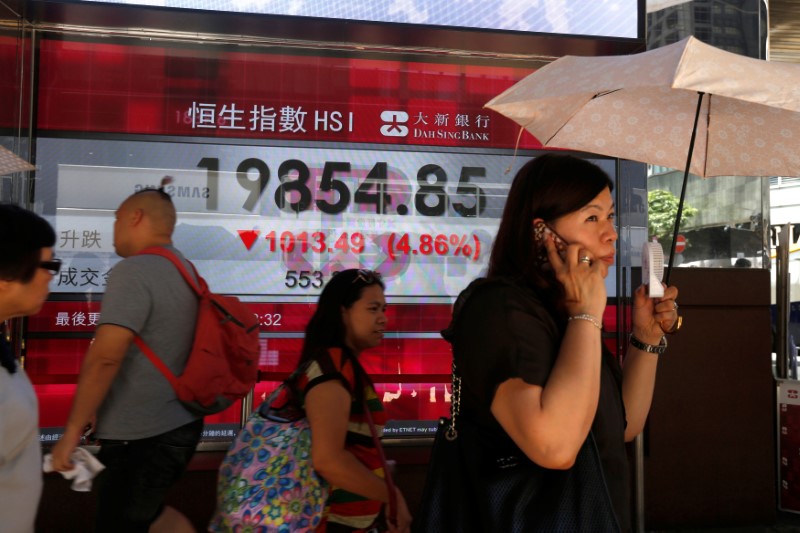The buoyant mood on Wall Street flowed through to most Asian markets on Friday with Japan’s Nikkei closing at another 34-year peak.
The Nikkei 225 was up 0.92% at the close in Tokyo, while the Hang Seng in Hong Kong jumped by 2.4%, and stocks in Australia and India were also boosted. The Nikkei enjoyed its third straight week of gains, rising 4.3% this week. This brought its year-to-date improvement to a staggering 15%.
MSCI’s broadest index of Asia-Pacific shares outside Japan rose 0.9%, helped by a 2.6% jump in Hong Kong’s Hang Seng index after returning from the Lunar New Year holidays. The Hang Seng was up 1.9% for the week.
Markets on mainland China remained closed on Friday.
ALSO SEE: Google Set to Launch Satellite to Pinpoint Methane Emission Sites
The best performers of the session were Mitsui Engineering & Shipbuilding, which rose 15.7%, while Rakuten was up 6.5%. The worst performers were Trend Micro, which sank by 17.2% and Sumco Corp, which fell by 5.25%.
Foreign investors increased their purchases of Japanese stocks last week as easing concerns over the Bank of Japan’s (BOJ) potential policy shift buoyed market sentiment. According to data from Japanese exchanges, foreigners accumulated a net 817.43 billion yen ($5.44 billion) of local stocks in the week to February 9, marking their most substantial weekly net purchase since January 12.
Meanwhile, BOJ Governor Kazuo Ueda said on Friday that monetary policy would most likely remain accommodative, even after ending negative interest rates, echoing recent reassurances from BOJ officials that have weighed on the yen.
The yen eased 0.2% on Friday to 150.26 per dollar, back above the critical 150 level that could draw possible Japanese intervention to slow the currency’s declines.
“The dollar/yen has sort of consolidated around the 150 level, so that’s providing support (to Nikkei). There’s the corporate reform still going through, so the exporters will continue to do well,” said Tony Sycamore, market analyst at IG.
Figures on Thursday showed that Japan and Britain slipped into recession at the end of last year, and US retail sales last month fell much more than expected. But the upshot of that could be relatively looser monetary policy.
“I think the demand picture is certainly starting to fracture in some of the developed market economies,” said Sycamore. “So it does bring forward the idea of rate cuts.”
US retail sales down fell in January
Overnight, data showed the US retail sales fell by 0.8% in January, the sharpest drop in 10 months.
Markets moved to fully price in a rate cut from the Federal Reserve in June, reversing some of the price action after a stronger-than-expected US inflation report prompted traders to give up bets for early rate relief.
That cheered Wall Street, with the S&P 500 gaining 0.6%, the Nasdaq Composite up 0.30% and Dow Jones Industrial Average firming 0.9%.
The repositioning in interest rate expectations weighed on the dollar, but it rebounded 0.1% to 104.41 against its peers on Friday, after losing 0.4% overnight.
Treasury yields bounced after dipping overnight. The yield on benchmark 10-year notes rose 2 basis points at 4.2576%, after slipping 3 basis points overnight. It was still up 8 basis points for the week.
Hong Kong and Australian stocks higher
Hong Kong’s Hang Seng index shot up on Friday as traders piled into China-exposed stocks before the reopening of mainland markets after a week-long holiday next week.
The Hang Seng rose 2.4% – close to a one-month high, with heavyweight mainland stocks seeing a bulk of gains. Real estate developers Longfor Properties, Country Garden Services Holdings and China Resources Land rose between 5% and 9%, while WuXi Biologics surged 12.5% as it rebounded from steep losses earlier this week.
Local media reports showed that Chinese travel demand rose sharply during the week-long Lunar New Year holiday, driving up some hopes that consumer spending was recovering from a three-year rout.
But whether the increased holiday spending will translate into broader improvements in the economy remains to be seen, especially as Chinese economic activity showed little signs of picking up before the holiday.
The Chinese economy was battered by a prolonged property market crisis, while sluggish consumer spending saw the economy slip into deflation by end-2023. While the government had rolled out monetary support, it did little to spur growth or offset a deepening rout in local stock markets.
The People’s Bank of China is now expected to keep its benchmark loan prime rate unchanged near record lows this Tuesday.
Meanwhile, in Sydney, the ASX 200 was up by 0.69% at the close with gains in gold, metals and mining, plus resources. IGO and Pilbara Metals were among the best performers, while Inghams Group was the worst loser, falling 12.7%.
India’s Nifty 50 up 0.59%
India stocks were higher after the close on Friday, with gains in the auto, real estate and capital goods sectors.
At the close in NSE, the Nifty 50 gained 0.59% to hit a new 1-month high, while the BSE Sensex 30 added 0.52%.
The best performers on the Nifty 50 were Wipro Ltd, which rose 4.73%, while Mahindra & Mahindra added 3.99% and SBI Life Insurance was up 3.8% in late trade.
The worst performers were Power Grid Corporation of India, which fell 2.5%. Oil And Natural Gas Corporation declined 0.94% and State Bank Of India was down 0.92%.
The upbeat mood in Asia then carried on to Europe, with the STOXX 600 hitting its highest since January 2022.
With the dollar in the ascendant, gold has been under pressure this week. The spot price is heading for a weekly fall of nearly 1%, its biggest weekly decline since late December.
Gold, which has traded consistently above $2,000 an ounce for most of the past two months, was flat at $2,005.
Oil prices fell on Friday after jumping the previous session. The International Energy Agency on Thursday flagged slowing demand growth this year.
Brent crude eased 0.9% to $82.11 a barrel, while US futures fell 0.7% to $77.43.
- Reuters with additional editing by Jim Pollard
ALSO SEE:
Nvidia Chief Pans Sam Altman’s Trillion-Dollar AI Chip Plan
Google Set to Launch Satellite to Pinpoint Methane Emission Sites
Red Sea Crisis Hurting Indian Exporters As Rivals Nab Business
























